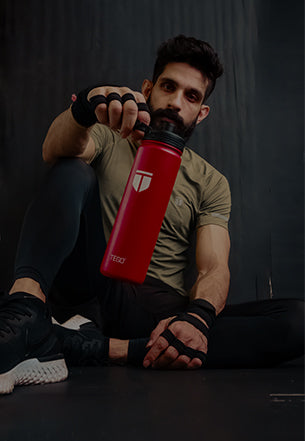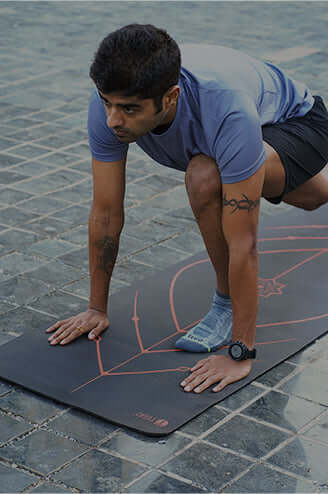Why India's wettest season isn't a reason to stop. It's a reason to step up smartly.
When the rain hits, most people reach for their phones with the reflexive urgency of a trader checking closing prices. They cancel workouts with elaborate justifications, and try to rationalize their retreat with another round of masala chai and manufactured sympathy for their own comfort.
Some, on the other hand, lace up with the quiet determination of someone who understands the difference between convenience and commitment.
This isn't about making dramatic social media posts. It's about smart planning. Because you've learned a truth that most people miss: showing up when it's actually hard is what separates occasional fitness enthusiasts from those building something that lasts for decades.
But let's be realistic about this. Monsoon running in India isn't the movie scene you might imagine. The humidity will feel like breathing through a wet towel. The roads weren't built with proper drainage in mind. You can't see much when it's pouring. And your usual running route might now be a slip-and-fall waiting to happen.
1. Gear Up for the Conditions You're In
Skip the Racing Shoes
If you're entertaining thoughts of breaking out those ultra-light, carbon-plated racing specimens with their sky-high foam and barely-there outsoles - the engineering marvels that make you feel like you could qualify for Boston just by putting them on - resist that impulse entirely.
These shoes are built for dry roads and race day, not slippery Indian sidewalks, or the potholes that show up overnight when it rains hard. In wet conditions, they go from helping your performance to being dangerous.
What you need instead: daily training shoes with aggressive tread patterns, wider contact patches for stability, and durable rubber compounds that grip on wet surfaces. Look for shoes built like all-terrain vehicles rather than race cars - prioritizing sure footing over speed. Think Land Rover capability, not Formula One precision.
Dress Like You Actually Know Better
Cotton? There are performance blends that work well for training and quick runs, but probably not ideal in the rains; there’s better. It’ll soak up water, stick to your skin, and start smelling like you ran in the rain.
Fully waterproof jackets? No way. In India's humidity, they turn into personal saunas where you'll overheat from your own sweat.
What actually works:
-
Quick-dry synthetic fabrics that move sweat away from your body
-
Light rain jackets for those sneaky showers that turn heavy fast
-
Caps with brims to keep rain out of your eyes
-
Bright colors so people can see you in poor visibility
Think comfortable, light, and practical. Don't overcomplicate it.
2. Your route should be a strategy, not a vibe.
That 5K loop you run every morning? It might be underwater right now.
Smart route planning means thinking ahead:
Avoid: Low areas that flood, loose tiles that get slippery, footpaths that look line an unfinished jigsaw puzzle, construction zones with poor drainage.
Choose: Parks with good drainage, roads that slope properly so water runs off, well-maintained paths that don't turn into streams.
Always know where you can take shelter: Covered walkways, petrol pumps, metro stations. Not because you're planning to quit, but because you're being smart about your options.
This isn't about being over-cautious. It's about being prepared. That's how you keep running consistently when others are making excuses.
3. Train Smart. No Theatrical Bravado.
Running in the rain doesn't make you tougher automatically. But training intelligently in tough conditions builds something valuable: the ability to adapt.
Cold muscles plus wet conditions plus no warm-up equals injury. Warming up takes a bit longer in the rain, so make sure you do so indoors. You're protecting your body, which is what makes everything else possible.
Take shorter, quicker steps to reduce chances of slipping, especially when you're trying to run fast and might not be watching where you step.
If there's lightning or really heavy rain (over 25mm per hour), use a treadmill instead. No shame in being safe. There are no prizes for being reckless.
Remember that strength training and recovery days count as real training. Skipping one outdoor run because of weather, isn't giving up. It's making a smart choice.
4. Don’t forget post-run care
Fear the Sloppiness - Not the Rain
You're not more likely to fall sick just because you ran in the rain. What gets you is the aftermath: staying in wet clothes too long, skipping a proper shower, ignoring foot care, or eating sketchy street food when your immunity is already taxed.
Your post-run routine should be efficient and thorough:
Change out of wet clothes immediately. Soaked technical fabric for a prolonged period creates perfect conditions for skin irritations and discomfort.
Take care of your feet. Dry them completely, especially between your toes where moisture causes problems. Your feet are your most important running equipment.
Stuff your shoes with newspaper and change it every few hours. Don't use hair dryers or put them in direct sun. Heat warps the foam and ruins the shoes.
Avoid Skin flare-ups; use an antifungal soap post-run if you’ve sensitive skin. The monsoon isn’t just wet - it’s a petri dish, and your skin doesn’t need the extra drama.
5. Fuel Your System Like the High-Performance Machine It Is
Monsoon season is hard on your immune system, and training adds more stress. Your body needs extra support.
Keep water on you always - even if you don’t feel thirsty. You don’t want to be scanning random tapris mid-run.
Eat to stay healthy: Vitamin C from citrus fruits and amla, zinc from seeds and lentils, and stick to clean, properly cooked food. No street food during monsoon season, no matter how good it looks.
6. Make Monsoon Runs a Habit, Not a Hurdle
Set a weather alert: Know if you're running in a drizzle or a downpour, even when the forecast’s rarely accurate.
Lay out your gear the night before: Fewer decisions = fewer excuses.
Have a post-run ritual: Dry socks, warm shower, ginger tea. The perfect playlist. It builds positive reinforcement.
Wear reflective gear: Use reflective elements or neon accents on your runs - especially after dark. You’re not trying to win a fashion show; you’re trying to be seen.
7. The Right Mindset for Monsoon Running
You're not running through storms to prove how tough you are or to post dramatic photos. You're showing something more important: consistent discipline that builds over time.
You're building mental strength along with the physical, which lasts beyond the rainy season, and translates into other aspects of your life - work, relationships, and everywhere else.
While others wait until October for perfect weather, you keep moving forward. Not dramatically, just steadily and smartly.
The Bottom Line
The weather will change. The humidity will go down. The roads will dry up. But the habit of showing up consistently when it’s actually difficult? That builds up over time and becomes part of who you are.
Just be smart about it - share your route with someone, know your limits, and if things look risky - hit the treadmill. No ego, just progress.
Train intelligently. Run with purpose. Keep moving forward.
Everything else is just weather.







